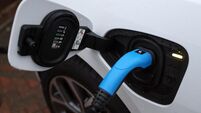Eco energy company rides on a wave of success
Operating in some of the most extreme weather conditions in the world, the first reliable constant flow of wave power ever produced in Irish waters is being generated in Galway Bay by the OE Buoy, a quarter-scale, 28-tonne prototype which has survived winter storms and 50-year wave conditions over its last two years at sea.
Announcing the move to raise investment capital of up to €20m in the next six months, John Keating, commercial director of Ocean Energy (OE), stated yesterday that the company is poised to generate commercially viable electricity to meet Ireland’s energy demands and helping to provide a security of energy supply for Ireland.
With global oil reserves in decline and as fuel prices fluctuate widely, OE is leading the race to harness the untapped power of the seas around Ireland, which based on research, are considered to be among the best locations on the planet.
Test results show that when a single full-scale turbine is connected to the national grid it would generate sufficient power to provide electricity for over 1,200 houses per year.
The OE plan is to create a network of energy farms in the Atlantic, each comprising 50 inter-connected units and generating the annual electricity supply for 60,000 houses.
“We’re very excited by the results generated from the buoy in Galway Bay during the past two years,” says Keating. “We installed a turbine in the system in August 2007 and she’s out there generating power right now.”
Following Britain, Spain and Portugal, the Government is committed to providing grid-connected infrastructure for wave power. The wave energy target in the Programme for Government is 75 megawatts of electricity by 2012 and 500 megawatts by 2020.
Cutting-edge R&D technology and engineering have gone into developing this wave power prototype. Initial tests carried out on a scale model of 1:50 at UCC’s Hydraulic and Maritime Research Centre (HMRC) in Cork optimised the hull configuration and demonstrated the potential power output of the device under north Atlantic conditions.
Using sophisticated computer modelling, it’s capacity to efficiently capture wave energy was confirmed in further testing of a 1:15 scale device in the large test facility at Ecole Central de Nantes, France.
Dr Tony Lewis of HMRC says the OE results are “confirmation of OE’s potential” and believes Ireland has incredible potential for wave energy generation. “If we could capture this opportunity then we have the potential to create a substantial number of jobs, solve our energy problems and become a world leader in the production of wave energy devices.”
With 30 years of experience working in an offshore environment as a commercial diver and salvage operator, Cobh-based Michael Whelan, managing director of OE and co-founder of the project, knew that laboratory tests were no substitute for the harsh reality of hurricane-force gales.
By November 2006, a 28-tonne model, assembled at Cork Dockyard, underwent stability sea trials in Cork Harbour. Launched off the West coast on Christmas Day 2006 it was to face the full force of winter storms.
Under severe conditions, the quarter-scale prototype was soon proving itself in 22 metres of water just over one kilometre off the village of Spideal, a designated test site controlled by the Marine Institute. On surviving the worst winter storms, a turbine was installed.
“Since we put her out there, she has passed every test with flying colours,” says Whelan. “She has endured the roughest winter storms, surviving 50 year waves and continues to generate power.”
The next step in the commercial rollout of the project will be a 32-metre device planned to go into the water in 2009. The principle behind the system is relatively simple. Wave power is harnessed as water rises in a large chamber, displacing air and forcing it through a turbine to produce electricity.
Fully scaled up, each device will have an installed capacity of between 1.5 and 2 megawatts, producing the equivalent of 4 million kilowatt hours of power annually, enough to supply the needs of 1,200 houses. The device will weigh over 600 tonnes and each unit will be 50 metres long and 24 metres wide.
From a network of 100-megawatt farms an umbilical connector would channel electricity to a central unit on the seabed and from there by cable to a land grid for distribution over the electricity network.
“No other company in the world has spent as long in a live sea-state environment or has the volume of test results that we have generated,” says Keating.
“Wave power will be a key component in the future energy mix of our country. A global business worth over €200bn is sitting on our doorstep and this country has the potential to make that a reality.”
















